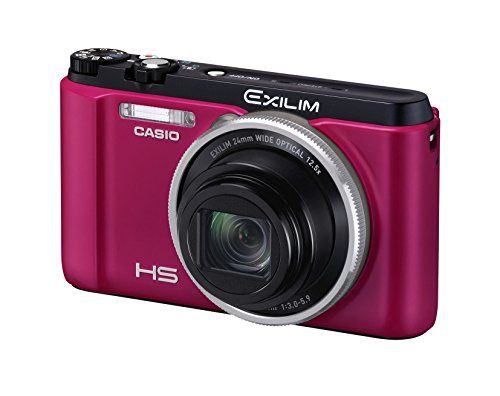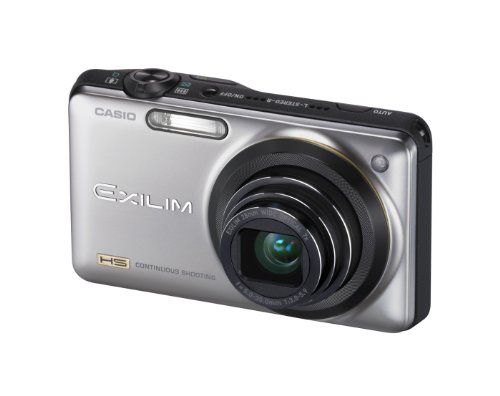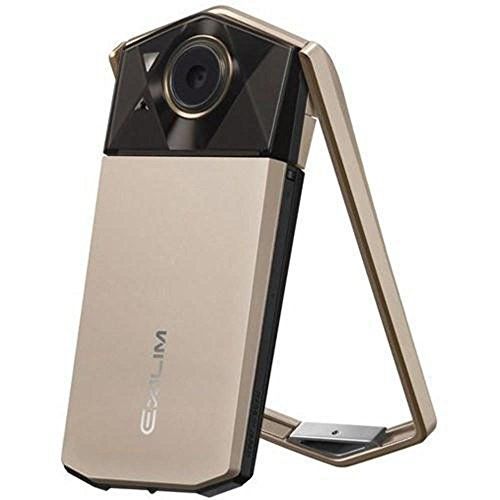Categories

Casio has been a well-known electronics brand for decades, originally starting out manufacturing calculators and keyboards. They entered the digital camera market in the mid-1990s and have become a reputable name for affordable, feature-packed point-and-shoot cameras.
Casio's camera lineup includes everything from budget-friendly compact models to advanced high-zoom bridge cameras. They are particularly well-known for their rugged and waterproof camera models, which can withstand drops, water submersion, dust, and freezing temperatures. This durability makes them a popular choice for active lifestyles and travel.
While Casio may not have the prestige of top-tier camera brands, their products consistently offer excellent value by packing impressive features into affordable packages. Their cameras are very beginner-friendly but also satisfy more advanced users looking for versatility without the high price tag.
Important Features
Casio cameras are known for their ability to pack powerful features into compact bodies. Here are some of the key highlights:
Resolution
Casio cameras offer a range of resolutions to suit different users. Entry-level models start at around 10 megapixels, while higher-end models can go up to 20 megapixels or more. This gives you plenty of resolution for printing high quality photos.
Zoom Capabilities
Given their compact size, Casio cameras manage to integrate impressive optical zoom capabilities. Zoom lengths range from 5x on basic models up to 10x or higher on premium long-zoom models. Some models also offer wider angle 24-28mm equivalent lenses for capturing landscapes.
Battery Life
Thanks to energy efficient components, Casio cameras can capture up to 300 shots per charge. Some models utilize specially designed lithium ion batteries that enable up 500 shots from a single charge.
Size and Weight
Weighing as little as 4-6 ounces, Casio cameras are highly portable. Some slimmer models can slip into a shirt pocket. The compact size makes them easy to take everywhere without weighing you down.
Image Quality
Casio cameras are known for their excellent image quality, thanks to their innovative sensors and image processing technology. Here are some of the key factors that contribute to the outstanding image quality of Casio cameras:
Image Sensor Size and Quality
Casio uses larger image sensors in its cameras compared to smartphones and cheaper point-and-shoot cameras. The larger sensor size allows for bigger pixels that can capture more light. This results in less noise, better dynamic range, and superior image quality, especially in low light conditions. Many Casio cameras use premium sensors that are on par with more expensive DSLRs and mirrorless cameras.
Low Light Performance
The large sensor size combined with Casio's state-of-the-art image processing engine delivers exceptional low light performance. You can shoot sharp, clean images even in very dim lighting without the use of flash. The cameras have excellent high ISO performance with low noise through a wide ISO range. This allows handheld shooting indoors and capture of fast-moving subjects even in low ambient light.
Color Accuracy
Casio cameras produce vibrant, true-to-life colors thanks to their advanced image processing algorithms. The white balance is very accurate leading to natural looking colors in different lighting conditions, including under fluorescent or incandescent lights where colors can often look skewed. The saturation and contrast are optimized to deliver punchy images without looking artificial. Overall, the color reproduction is highly realistic.
Ease of Use
Casio cameras are designed with beginners in mind and emphasize ease of use. The intuitive menu system uses clear icons and descriptions, making it simple to access and adjust settings. Most models feature an auto mode that sets everything for you, so you can just point and shoot.
Scene modes are also prevalent in Casio cameras. These presets optimize settings for different situations like landscapes, portraits, night scenes, and action shots. Rather than figuring out aperture, shutter speed, and ISO, you can rely on the scene mode to dial in the best configuration based on the type of photo. This takes the guesswork out of photography and makes it easy capture great shots in a variety of conditions.
Some models like the Exilim EX-ZR1500 have a macro scene mode for brilliant close-up shots. The pet scene mode ensures your furry friends always look their best. For capturing text or diagrams clearly, there is even a business card mode. Casio packs its cameras full of intelligent auto and scene modes so you get excellent results without any photography expertise required.
Connectivity
Casio cameras offer great connectivity options to make sharing photos and videos easy. Most models include built-in WiFi and Bluetooth which allows you to wirelessly transfer images and videos to your smartphone or tablet. Many also have NFC one-touch pairing to instantly connect your camera to a mobile device.
The WiFi functionality enables several convenient features. You can remotely control the camera shutter from your smartphone, allowing you to frame shots without touching the camera. This is helpful for taking self-portraits or group photos where you want to be in the picture. WiFi also lets you automatically transfer images to your mobile device as you take them. For social media users, this makes it easy to share high quality photos on the go directly from the camera.
Casio cameras work with the Casio Image Transfer app for iOS and Android. This gives you full control over wireless image transfer. You can automatically sync all photos to your device, selectively choose which images to transfer, or manually transfer photos individually. The app also allows remote shooting and camera control.
Overall, Casio packs great wireless connectivity into their cameras. File transfer and sharing is seamless thanks to the robust WiFi, Bluetooth, and app integration. This allows you to easily upload high resolution images to social media or cloud storage services directly from the camera.
Special Features
Casio cameras are known for having robust special features that enhance the photography experience. Here are some of the standout special features found in Casio cameras:
Waterproof/Rugged Capabilities
Many Casio point-and-shoot cameras are waterproof and ruggedized. They can withstand splashes, rain, dust, drops, and more. For example, the Exilim EX-FR10 camera is waterproof up to 16 feet, shockproof up to 5 feet, dustproof, and freezeproof to 14°F. The rugged construction allows you to take this camera to the pool, beach, ski slopes, and other adventurous locations without worry.
GPS Tagging
Some higher-end Casio cameras contain built-in GPS for automatic geotagging. The Exilim EX-H20G camera has a hybrid GPS system that tags your photos with the location they were taken. It can even track your route and display it on a map. This makes it easy to remember exactly where your travels took you.
Panorama and Timelapse Modes
To expand your creativity, several Casio cameras offer panorama and timelapse modes. Panorama mode stitches together multiple shots into one seamless panoramic image. Timelapse mode creates mesmerizing videos by capturing frames over long periods of time. For example, the Exilim EX-ZR800 has an autopanorama mode as well as high speed video and interval still modes for producing creative timelapse videos.
Video Capabilities
Casio cameras offer excellent video recording capabilities in addition to their high-quality still image capture. The maximum video resolution available on most current Casio camera models is 4K at 30 frames per second. Some higher-end models can record 4K video at up to 60fps for smooth, high-resolution footage.
Casio cameras use the H.264 video compression format to create highly compressed video files without sacrificing quality. This allows you to record longer videos without taking up massive amounts of storage space. Most models also offer lower resolution HD (1080p) and SD video options if desired.
Slow motion and time lapse modes are available on select Casio cameras, allowing creative video effects. Overall, Casio cameras provide versatile high-quality video recording to meet both amateur and professional needs. The combination of high resolution, smooth frame rates, and efficient H.264 compression makes them capable video tools.
Available Lenses and Accessories
Casio cameras come with a standard kit lens to get you started, but there are additional Casio-branded lenses available to unlock the full potential of your camera.
Casio Lenses
Standard zoom lenses - These cover focal lengths from wide angle to short telephoto, ideal for general photography. Popular options include 16-50mm, 18-55mm, and 18-135mm.
Telephoto zoom lenses - Get you closer to the action with focal lengths typically from 70-300mm. Great for sports, wildlife, and portraits.
Wide angle zoom lenses - Wider focal lengths like 10-24mm allow you to capture expansive landscapes and architecture. Useful for real estate and interior photography.
Prime lenses - With a fixed focal length, these offer exceptionally sharp images and low light performance. Popular primes include 35mm, 50mm, and 85mm.
Macro lenses - Specialized optics provide 1:1 magnification for extreme close-ups of tiny subjects like insects and flowers.
Portrait lenses - With wide apertures like f/1.8 or f/1.4, these give beautiful background blur and subject isolation.
3rd Party Lenses
Popular 3rd party manufacturers like Sigma, Tamron, and Tokina offer lenses for Casio cameras. These give you more options for specialty lenses at lower price points. They are fully compatible with all camera functions.
External Flashes
For supplemental lighting, Casio cameras support external flash units from Casio as well as 3rd parties. These connect via the hot shoe mount and some offer tilt/swivel for bounced lighting. Features like high-speed sync allow flash use at higher shutter speeds.
Price and Value
Casio cameras offer excellent value for money across a range of price points. Here's a look at what to expect:
Budget Models
Casio's most affordable point-and-shoot cameras start around £80-£120. These deliver decent image quality and performance for casual photographers. Key features include:
Resolution of 10-16MP
3x optical zoom lens
720p or 1080p HD video recording
Intelligent auto mode
2.7" LCD screens
Great options for beginners and those seeking a portable second camera. The low prices make these models very accessible.
Mid-Range
Step up to £150-£300 for more advanced features and image quality. These models add:
Higher resolution 16-20MP sensors
5x-10x optical zoom lenses
Manual exposure controls
RAW image capture
Larger LCD screens
Ideal for photography enthusiasts seeking lots of control over settings. Performance rivals more expensive models.
Premium Compacts
At the top end, Casio's premium compacts cost £300-£500. These pack in the most features:
Large 1" or APS-C sensors for significantly better image quality
Wide aperture lenses for blurred backgrounds
Phase detection autofocus for fast performance
4K video recording
Full manual controls and RAW capture
DSLR-style body with EVF
Provide a near-DSLR experience in a compact body. Great choice for professionals and serious hobbyists.
Overall, Casio delivers excellent value across all price tiers. Lower-cost models offer impressive quality for the prices, while premium options still cost hundreds less than interchangeable lens cameras with similar capabilities.
Ideal Users
Casio cameras are a great choice for a variety of users including beginners, travelers, families, and more. Here's a closer look at who can benefit most from a Casio camera:
Beginners
Casio cameras are very easy to use, even for someone who has never used a digital camera before. Many models have an Auto mode that will select the optimal camera settings for you. This takes the guesswork out of using manual settings like aperture and shutter speed. The intuitive menus and controls make Casio cameras perfect for photography beginners.
Travelers
These cameras are lightweight, compact, and durable - ideal traits for travel photography. Many models are pocket-sized so you can take them anywhere without weighing yourself down. The rugged build can withstand adventures like hiking and beach trips. Some Casio cameras are also waterproof or shockproof for added protection.
Families
Casio cameras are affordable and user-friendly, making them a smart choice for family photography. Busy parents will appreciate how quick and easy it is to capture high-quality photos of kids and vacations. The budget price tag allows you to buy cameras for multiple family members without breaking the bank.
Vloggers
Several Casio camera models offer excellent video capabilities for vlogging and social media. You'll find features like high-resolution video, flip screens, microphone inputs, and more. The compact size also makes Casio cameras highly portable for filming on the go.
So in summary, Casio cameras are a versatile choice suitable for many types of users thanks to their combination of simplicity, portability, features, and affordability. Beginners, travelers, families, vloggers, and more can benefit from owning one of these easy-to-use cameras.
Casio Cameras comparison
 |  |  |  |  | |
|---|---|---|---|---|---|
| Model | Casio Exilim EX-ZR400 | Casio EXILIM EX-Z8 BK | CASIO EXILIM EX-ZR1300VP | Casio Exilim EX-ZR10 | Casio Exilim EX-ZS200 |
| Brand | Casio | Casio | Casio | Casio | Casio |
| Model Number | EX-ZR400WE | EX-Z8BK | EX-ZR1300VP | EX-ZR10SREDA | B406485 |
| Camera Lens | - | 28 mm | - | 28 mm | - |
| Colour | White | Black | purple | Silver | white |
| Continuous Shooting Speed | 15 fps | - | 30 | 3 fps | - |
| Effective Still Resolution | 16 MP | 8.1 MP | 16 MP | 12.1 MP | 16.44 |
| Focus Type | - | - | - | - | Auto Focus |
| Has Image Stabilisation | Yes | - | - | Yes | Yes |
| Item Weight | 205 Grams | 178 g | 256 Grams | 149 Grams | 212 Grams |
| Max Focal Length | 300 Millimetres | 114 Millimetres | - | 196 Millimetres | 600 Millimetres |
| Maximum Shutter Speed | 30 seconds | - | - | - | 30 seconds |
| Memory Slots Available | 1 | - | - | - | - |
| Min Focal Length | 24 Millimetres | 38 Millimetres | 24 Millimetres | 28 Millimetres | 25 Millimetres |
| Minimum Shutter Speed | 1/4000 seconds | 4 seconds | 1/16000秒 | CMOS電子/メカシャッター併用シャッタースピード※:オート:1~1/2000秒夜景:4~1/2000秒 | 1/2000 seconds |
| Model Year | 2013 | - | - | 2010 | 2012 |
| Style | - | - | Int'l Version | - | - |
| Zoom Type | Optical Zoom | Optical Zoom | - | Optical Zoom | - |
| Photo Sensor Size | - | - | - | - | 1/2.3-inch |
| Model Name | Exilim EX-ZR400 | EX-Z8 | Exilim EX ZR1300 | Exilim EX | Exilim EX-ZS200 |
FAQ
What is Casio known for?
Casio is known for manufacturing affordable and innovative consumer electronics, including calculators, digital cameras, electronic musical instruments and watches. The company is especially well-known for making durable, feature-packed digital cameras at reasonable prices.
How long has Casio been making cameras?
Casio released its first digital camera, the QV-10, in 1995. So the company has over 25 years of experience developing digital imaging technology and products.
What types of Casio cameras are there?
Casio makes point-and-shoot compact cameras as well as more advanced bridge and mirrorless interchangeable lens cameras. Their cameras come in various zoom ranges to suit different users.
What features are Casio cameras known for?
Casio cameras are appreciated for their affordability, durability, compact size and speed. Key features include high-speed burst shooting, in-camera editing and filters, hybrid auto focus systems and long battery life.
Do Casio cameras take good pictures?
Yes, Casio cameras are very capable of taking high quality photographs, especially considering their reasonable prices. They have features to help capture sharp, vivid images in various conditions.
What is Casio's most expensive camera line?
Casio's top camera line is the Exilim EX-ZR series. These advanced compact cameras have premium features like wide-angle zoom lenses, super slow motion video and manual controls. They cost around £300-400.
Does Casio make professional cameras?
While Casio is better known for affordable compact cameras, they do have some more advanced interchangeable lens cameras like the Exilim EX-100 with prosumer features. But they do not make high-end professional cameras.
Are Casio cameras good for beginners?
Yes, Casio cameras are excellent choices for beginners. They offer user-friendly controls, built-in guides and modes for easy operation, and durable builds for new users. The simple menus and buttons make it easy to learn.
Where are Casio cameras manufactured?
Casio manufactures its digital cameras in factories in China, Thailand, and Indonesia. The components come from suppliers in Japan, China and Taiwan.
How do I charge a Casio camera battery?
To charge a Casio camera's lithium-ion battery, you insert the battery into the included charger and plug the charger into a wall outlet. Charging time varies by battery capacity but is usually around 2-3 hours.





